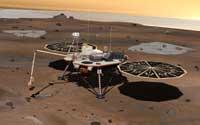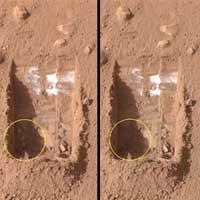The Adventures of Phoenix on Mars

In fact, in 2008 began and ended the role of Phoenix, the grounding on Mars and the measurement of its characteristics. Of course, this allowed scientists to know things about Mars. All in one.
Through Phoenix scientists want to know things about Mars. Among other things, they hope to know if there was or can be life on Mars and want to describe the climate of Mars and study the geology of the planet.
May 25 first touched the surface of Mars. He pierced the red planet, took out the plots and studied them. In addition to this data, Phoenix took some 25,000 photographs.
To send all the information obtained to Earth, as the probe itself will never return to us, NASA turned to two probes that revolve around Mars. These probes serve as an intermediary and facilitate communication between Martian surface instruments and NASA scientists.

Phoenix first touched the surface of Mars on May 25 and completed its mission on November 11. (Photo: NASA/JPL-Caltech/University of Arizona
Looking for water
Scientists will analyze in detail the data obtained, but NASA has already released some results. They have been mainly news related to the emergence of water. In June it is confirmed that Phoenix discovered ice in the ground with a hole. In the hole appeared some lumps that could be ice or salt. Days later, however, they saw that some of those lumps were sublimated, becoming gases. And salt does not sublimate.
This ice could be frozen water, but not necessarily, and also frozen carbon dioxide. Looking at some plots, Phoenix showed that ice was icy water. He also detected snowflakes in the atmosphere of Mars. However, these flakes did not reach the surface of the planet, but were sublimated along the way.
Why do they have that obsession with water? For on Earth, in ours, water is an important component. The life we know would not be possible if there was no water. Therefore, if there is water on Mars, there may be life.

Ice cubes found underground by Phoenix were discovered and disappeared a few days. In the image on the left you can see the lumps and the one on the right is a picture taken in the same field, without lumps. (Photo: NASA/JPL-Caltech/University of Arizona/ Texas A M University
Start and end
The march from Phoenix to Mars was fruitful. Like everything, it's over. Before sending it the scientists knew it was not going to be very long.
After all, he was sent to the North Pole of Mars, which had to arrive the winter before or after. With the arrival of winter, little by little the energy that came from the Sun was decreasing and gradually its activity was slowing down, since it obtained from it the energy necessary to work.
However, it remained more than expected. At the time of shipment it was expected to last approximately three months and finally went to work five. The mission of the Phoenix probe was completed on November 11.
Now scientists have a lot of data collected directly from Mars. Phoenix is in charge of giving and stays on Mars forever. And, until the opposite happens, it's just a lot of scrap. Who knows if next summer, when the Sun begins to warm up strongly, it will start again! Scientists have said that, just in case, they will continue to contact him...
Published in 7K.
Buletina
Bidali zure helbide elektronikoa eta jaso asteroko buletina zure sarrera-ontzian











